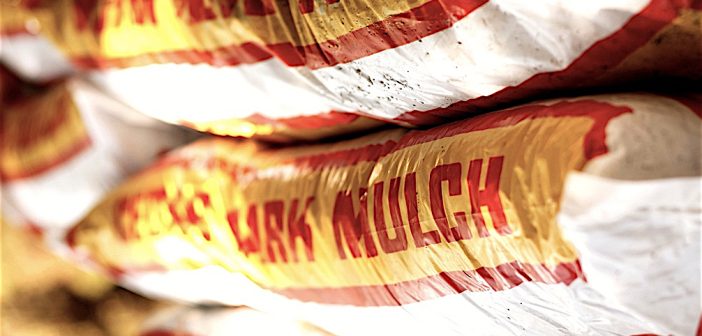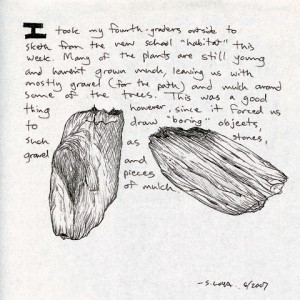Mulch will make a big difference in your planting beds. It helps to reduce evaporation, maintain soil temperature, and prevent erosion by holding soil in place during heavy downpours. Mulch controls weeds by smothering seedlings, and it helps keep fallen or low-growing fruits clean. Not only that, but as it decays over time, it improves soil composition and adds nutrients. Another plus is that mulch dresses up flower beds, giving them a finished look.
A ring of mulch around trees makes mowing easier. You can mow right to the edge and eliminate the need for trimming. (This has the added benefit of protecting tree trunks from damage caused by mowers and weed trimmers.)
There are a confusing number of different mulch products, and they have their own qualities. So, how do you decide what’s best? Base it on your intended use and the appearance you want. For example, some mulches, such as that from cereal crops, are strictly functional and don’t last a long while. You wouldn’t buy them to make a planting bed look pretty. Others, like those from hardwood trees such as oak, ash, and elm, last longer. Some wash away easily in heavy rain, and some mulches will stay put.
Below are the many kinds of readily available organic mulches. Except where otherwise noted, spread mulch evenly 2 to 3 inches deep (51–76 mm) around trees, shrubs, and perennials. An inch (25 mm) will do in a vegetable garden. For the best appearance and effectiveness, cover the entire bed. Don’t allow mulch to touch a tree trunk or plant stems; leave about an inch of space. A ring of mulch around a tree looks best when it covers an area 3 to 6 feet (1–2 m) out from the trunk. Keep mulch away from the foundation to help keep away insects and mice.
Apply new mulch in early summer, after the soil has begun to warm. The root development of newly installed plants will slow down if mulch is applied too early.
- Leaves: Quickly decompose, excellent for improving the soil. Be sure to shred them first with a mulching mower.
- Grass clippings: Quickly decompose. Keep the layers to 2 inches (51 mm) or less. Weed-free only if your lawn is. Allow clippings to dry before applying.
- Cocoa-bean hulls: Becoming more widely available but not recommended by the ASPCA. (The mulch’s chocolate-like scent, though short-lasting, is attractive to dogs, who may happily consume the hulls. Chocolate is poison to dogs.)
- Straw: A good winter mulch for the vegetable garden. Buy only weed-free straw. Avoid hay, which is weedy. Mulch 6-8 inches (15–20 cm) deep. Short-leaf pine straw is attractive on flowerbeds and doesn’t float or wash away.
- Sawdust: Not usually a good choice, except for pathways. Mulch 3 to 6 inches (8–15 cm) deep. It tends to cake and resist water absorption and also draws nitrogen from the soil.
- Newspaper: Especially good for weed control in a vegetable garden. Apply three layers, and weigh them down by covering them with another type of mulch.
- Bark mulch: Usually consists of by-products from pine, cypress, or hardwood. May be shredded or in chunks. Resists compaction, won’t blow away, attractive.
- Wood chips: Decompose very slowly. Good for paths, trees, and shrubs. Weathers to grayish color over time, losing some of its decorative appearance. Made of many different kinds of trees. Is often available free from municipalities or utility companies. Tree trimmers will often deliver a load free to your driveway to save on dump fees. There’s no quality control, so it may contain seeds. Be aware, too, that wood that hasn’t been aged can be harmful to tender stems and plants if placed too close.
- Cedar bark: Economical and usually stringy. Long-lasting. Good for paths, trees, and shrubs. May repel insects.
- Cypress mulch: Attractive and lasts longer than hardwood mulch. However, these trees are slow-growing, and their long-term survival is at risk, so there’s an ethical dilemma in buying this.
- Melaleuca mulch: An environmentally friendly alternative to Cypress mulch, this is from invasive Melaleuca species of trees.
- Redwood mulch: Although called “redwood,” it isn’t actually a product from Redwood trees. It’s made from recycled wood that has been dyed with coloring that’s safe for pets and the environment.
- Other dyed mulches: Colored with safe dyes, recycled wood is also available in yellow, natural, and black.
- Nuggets: Usually chunks of driftwood or pine bark, these last a long time. Not good for wet areas or slopes, as they float and will wash away.
- Pebbles and stones: Non-organic. Lasts forever, of course. Whether fine-textured or coarse, it won’t blow away. Allows water drainage but doesn’t hold moisture. Gives a “hard” look to beds, which suits some types of plants, such as cacti and other succulents. May lead to soil compaction. Reflects sun and heat.
Native plants for your wildlife
*Top photo: Phil Roeder / Flickr; cc by 2.0







